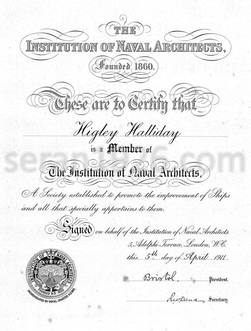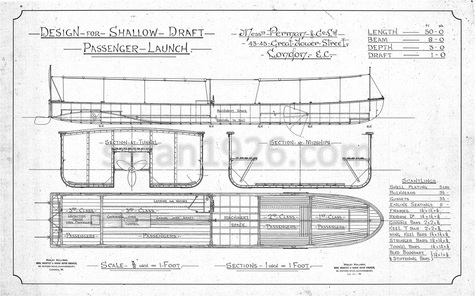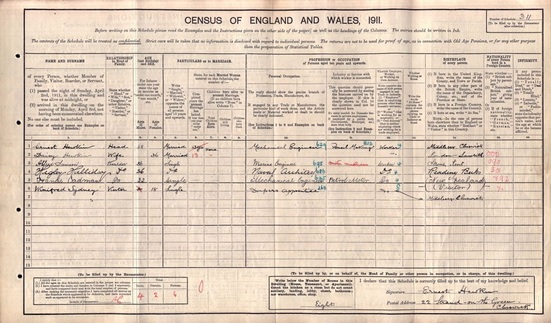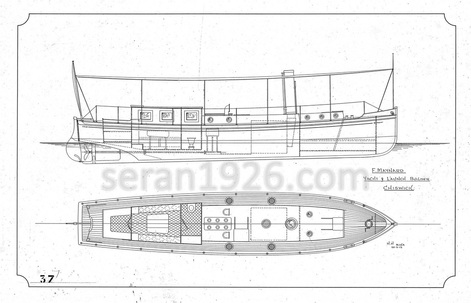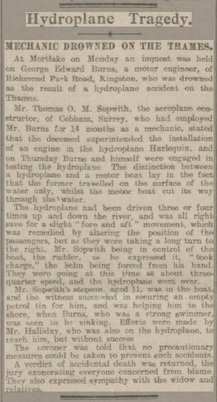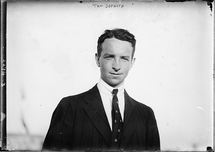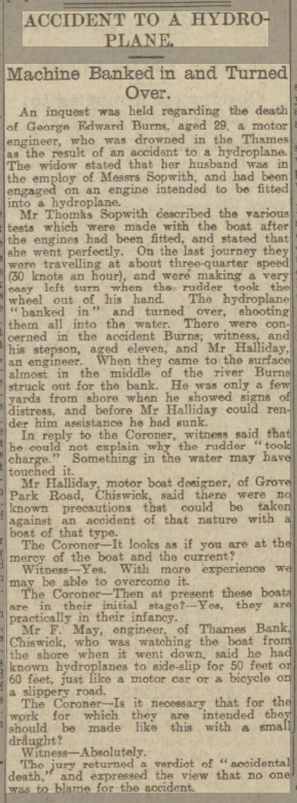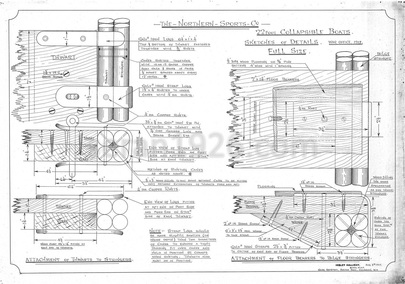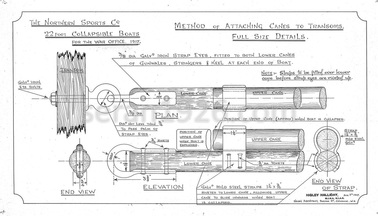III. Return to Chiswick
“Higley Halliday, Naval Architect & Marine Motor Engineer”
Halliday returned to London in 1909, after two years
working on the “Thompson’s hydroplane” project in Liverpool. Between 1909
and 1910 he was based at 67, Oxford Road, Gunnersbury, trading as
“Higley Halliday, Naval Architect & Marine Motor Engineer” and
would have been grateful for the continued support of Messrs. Perman &
Co. Ltd. who instructed him to design a 50 ft. shallow draft passenger
launch (c. 1910) and advise on the installation of an auxiliary 28 h. p.
Kromhout motor in the fishing lugger, ‘Sweet Hope’ (1910). During this
period Halliday undertook a broad range projects, including designs for
motor yachts (1910), a racing motor launch (1910) and a 60 ft. steamer of
riveted steel plate construction for J. Stanley Green (1909), together
with a number of sail and rigging plans for Classed yachts.
In 1911 Halliday was admitted as a Member of the Institution
of Naval Architects (M.I.N.A.) and was boarding at 22
Strand-on-the-Green, Chiswick. The Census of that year provides an
interesting snap shot of the boat building industry which
still dominated the riverside at Chiswick. The occupants of the
house include: Alfred Samson (36) Marine Engineer; Higley Halliday (36)
Naval Architect; Francis Cadman (22) Mechanical Engineer, petrol
motors.
Halliday's new lodgings were only a few hundred yards from
Frank Maynard's yard at Grove Park at the east end of Strand-on-the-Green. It
seems likely that Halliday collaborated with Maynard on an informal,
ad hoc basis, following his return to Chiswick in 1909. Maynard, like
Halliday, had been heavily involved in the British International Trophy and
Reliability Trials building his own designs, such as 'Opal', and indeed
the two competed against each other in the 1906 trials. Both had
also developed a close working relationship with Tom Thornycroft over the
previous decade. Interestingly, Halliday and Maynard also knew each
other socially; both were Freemason's with the same Masonic
Lodge - Royal Alfred Lodge No. 780 (initiated in 1904 and 1906
respectively).
Partnership with Frank Maynard, 1911 - 1926
Higley Halliday and Frank Maynard entered into a formal
business partnership in 1911 although this does not appear to have
been an exclusive arrangement for either party; for instance
Maynard built several launches to the design of J. A. Smith
and Linton Hope amongst others during the period.
Halliday was an active member of the British Motor Boat
Club and members provided him with a steady stream of design work through
to the early 1930's. In 1912 Halliday designed the 36 ft. motor
yacht ‘Amice’ for club member L. M. Waterhouse and, in September that
year, ‘Amice’ competed in the club's handicap race for cabin cruisers at
Burnham. She was subsequently requisitioned by the Admiralty during The First World War.
Halliday also designed the motor launch ‘Falcon’ in
1912 for Captain Cecil Pearce, Rear Commodore of the B.M.B.C., which
subsequently won the Dorset Motor Yacht Club handicap for yachts
over 20 knots in 1914. Both ‘Amice’ and ‘Falcon’
were built at Maynard’s yard.
By 1914 Halliday was a Member of the Institution
of Automobile Engineers (M.I.A.E.). This body had previously been the
Cycle Engineers’ Institute formed in 1898. The Institution had only
530 members in 1911 of which only a relatively small number were
specialised in marine motors and engineering.
In addition to his design and consultancy
work, Halliday had also established “The Halliday Carburettor Co.,
care of Frank Maynard’s Yard, Chiswick, London W4.”
First World War
From 1914 all available resources were directed to the war
effort. Halliday remained in Chiswick during this period, initially on
Grove Park Terrace and latterly, Bolton Road.
|
An intriguing episode occurred in July 1915 when Halliday
was involved in a hydroplane accident on the Thames at Chiswick. Also on
board were Thomas O. M. Sopwith, Sopwith’s stepson and a mechanical
engineer in the employment of Sopwith at the Kingston Aviation Works, called
George Edward Burns. The hydroplane, ‘Harlequin’, was of shallow draught and
fitted with a modified Sopwith aeroplane engine. It capsized whilst turning at
30 knots and Burns was drowned. The event was not widely reported at the time. Sopwith
was an experienced helmsman, having won the British International Cup in 1912
and 1913 in Sir E. Mackay Edgar’s ‘Maple Leaf IV’. No
further information has been found but it seems possible given Halliday's
relationship with Thornycroft, his work designing the 40 ft. “Thompson's
hydroplane” together with the date, location and individuals involved,
that the 'Harlequin' was a prototype of
the Coastal Motor Boat which was being developed by Thornycroft
for the Admiralty at Platt's Eyot at this time.
|
The full extent of his work for the Admiralty and
War Office during the First World War has not yet been established
but his designs of 22 ft. cane and canvas collapsible boats for the
War Office have survived, dating from August 1917.
Post War and the 1920's
Commercially, the immediate post war years and 1920’s marked
the peak of Halliday’s career. Aged 45 in 1920, he was an established and
respected naval architect and marine engineer and, being based near the
Thames at Chiswick, was well placed to benefit from the post war revival
in recreational boating on the river, in coastal waters and increasingly
on the Continent.
During the period to 1927 in particular, Halliday was a
prolific designer of all types of predominantly powered craft but, in particular,
it was his designs for bespoke, highly specified motor yachts and launches
which were reported in the yachting press of the day.
His partnership with Frank Maynard continued through the
first half of the 1920’s and during this period Maynard appears to have built
the majority of his designs. In 1926 the partnership was dissolved (Halliday
lost approximately £1,000) following which he increasingly approached other
Thames based yards including Tough Bros, Teddington, Taylor & Bates,
Chertsey, Herveys Yard, Isleworth and Hay and Sons, Rotherhithe amongst
others.
